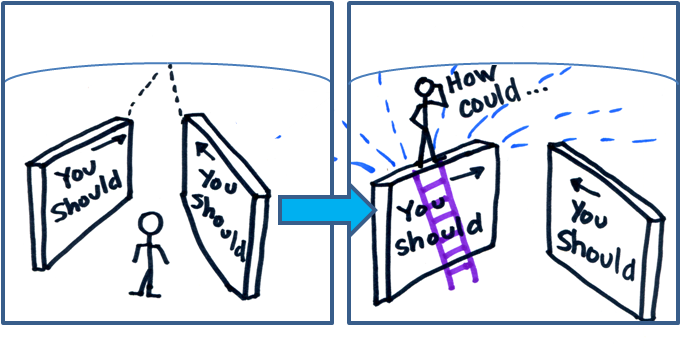In a complex world of interconnected social and environmental challenges, it is increasingly clear that no one organization can solve these alone. A new focus on “collective leadership” is emerging where people collaborate and align their work across organizations and traditional boundaries for greater impact. In this context, we need skills to engage the diversity of a system, tap the collective wisdom of a group, and prioritize strategic actions and learn and adapt as things change.
Strategic questions are a core collective leadership skill. The April gathering of the Leadership Learning Community’s Boston Learning Circle explored the art of asking strategic questions in the context of participants’ current network leadership challenges. This format provided a rich opportunity for dialogue about the nature of how we, as leaders, can use questions to engage and inspire people, to expand our perspective, and tap the collective wisdom of a group.
Questions Help Us Access Diverse Perspectives
Strategic questions are open questions that inspire movement, reflection, and lend themselves to situations where fresh thinking is needed. The answers we had yesterday are often not the answers we need to navigate into the future. Strategic questions enable people, organizations, and networks to move from the known (present) to the unknown (future) – adapting to new contexts and exploring possibilities. They help us expand our options, moving from the world of “you should” into the world of “how could?”

As the “conversation catalyst” at this meeting, I shared how I first experienced the technique of strategic questioning when working with Sustainable Step New England, running workshops to train “change agents” to adopt sustainability strategies. People came to our workshops and got inspired to go back and implement these new ideas in their organization or community. The question that came up quite frequently was: “This is great, now how do I convince my boss?” This is the heart of the challenge for anyone working in social change – how do we get other people to change or take action?
Fran Peavey, the social activist who developed the technique of Strategic Questioning, discovered that she was much more effective in enabling positive change by asking questions rather than telling people what to do or convincing them of her way.
“It’s a far superior strategy to get all the minds working on what needs to change, rather than to convince each person to do what we think is best.” -Fran Peavey
The potential power of collective leadership lies in accessing the diverse perspectives and intelligence of many people and weaving these together to develop innovative solutions and aligned action. Strategic questions are a key way to “get all minds working on what needs to change.” These are questions that are truly open, meaning not a yes/no question or a question that contains or suggests a solution. The best ones are those we do not know the answer to…the question draws us into a discovery process. We invite the person or group we are working with to discover the answer.
Here are some of the insights that emerged from our conversations:
- How has a good question changed your life and opened doors? It holds a mirror and reflects back to you, helps you realize the potential to create your own path, and realize the power you have over your circumstances. Also, a good question can open up options you did not realize you had.
- The most powerful questions are the ones that lead us to question our assumptions.
- It matters who asks the question and when. The same question asked by a different person or at not the right time may not be as effective.
- Strategic questions can be used to empower people and groups to find their own answers, rather than trying to convince them to do it a certain way.
- When you ask a strategic question, be sure you are willing to listen, really listen to the answer. Fran Peavey says “listen like there is a thief in the house.”
- “Why” questions can tend to put people on the defensive. You can reframe from “why do you think that?” to “what in your experience leads you to feel that is the way to go?” or “walk me through your thinking.”
- A participant shared the Ladder of Inference as a useful tool for examining our own assumptions and biases. It slows down the thought process and unpacks how we jump to conclusions. When groups use this framework, it can help engage across difference so that conflict can be used in productive ways.
Here are some examples of good strategic questions for network leaders:
- What can we do together that none of us can do alone?
- Share a story of the value you have found in this organization/network. What were the conditions that enabled this?
- What are the strengths and skills that I enjoy using that I can contribute most effectively here?
- Who else should be at the table or could we partner/connect to?
